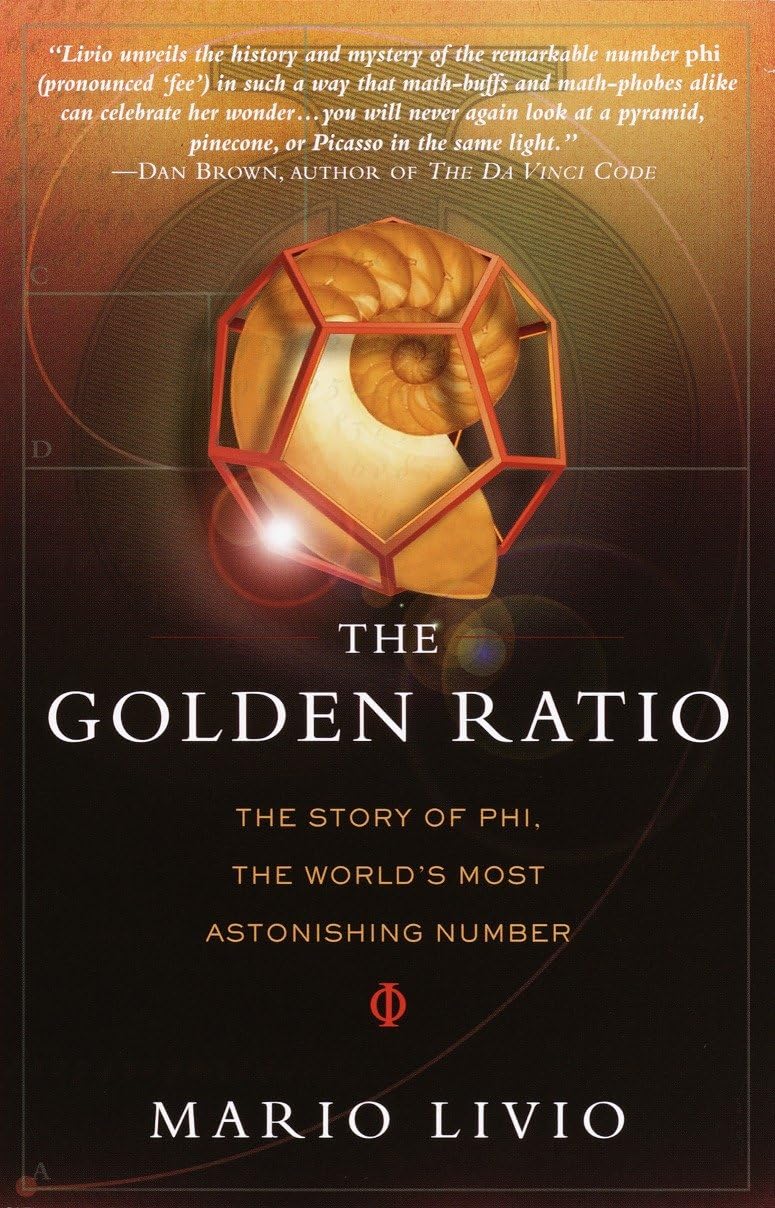

Full description not available



C**S
Beautiful math book that makes you appreciate the wonders of nature
Beautifully written book on the simplicity and the complexity derived from such simplicity, the subject of the Golden Ratio, where we find it in nature and man-made art and architecture. Simple read, straight to the point and factual
A**A
028 The Most Astonishing Number by Mario Livio
http://www.amazon.com/kindleforandroid/Indeed this is also a most astonishing book telling the story of a number. In bibliographical terms this book is mathematics, or slightly more narrowly history of mathematics. Nota bene! The number is not the well-known Pi (3,14..), related with circle, but equally well-known, not as a number but as ratio of long and short edge of an ideal four corner surface. Everybody knows and has a conception of what is a Golden Ratio without ever thinking it as a number. At least I bumped to the number reading this book, first time in my over 75 years of life. The magic number is PHI (1,618), the ratio of the long side to short side of any Golden cut surface. What is so special about that innocent-looking number?Read this book and you will be astonished. As if the whole Universe would be planned on the basis of this magic number: all 'natural' dimensions fron snow-flakes to the form of galaxies, masterpieces of painting, sculpture and music have this Golden ratio as the basic measure of their inner proportions. We seek it instinctively everywhere and are disappointed, if we do not find it. As an example I am extremely irritated of the brute deviation from this ideal of the format of paper journals; in addition to being unpleasant looking, they also are clumsily flabby for holding in hands.Despite of presenting the innocent looking simple number Phi (with alternative formulas behind it) this book plunges right away to the deepest mysteries of mathematics referring to dozens, hundreds of authorities. And yet, you will have no difficulty reading and understanding the text. High level mathematics is usually thought as pages full of formulas and dissertations of 20 pages, which very few persons understand. This book is not that way, although it goes far beyond mathematics requiring technical knowledge and skills. Just that is the fascination of the book. Embracing structures from flowers to houses and galaxies you get a fantastic feeling of better understanding what you see. Also another very rare feature is included. The host of personalities contributing to this discovery of hidden secrets of our world view are presented on everyday grass root level. Such well-known as Pythagoras, Newton, Gauss, Kepler, Einstein along with many less known but very important geniuses. Believe or not you have the feeling of meeting and chatting with them personally. A real magician this Mario Livio, five stars without any hesitation. Grateful to my friend Viljo, class mate beyond 60 years, who introduced this author to me. Reading already a second Amazon book by Livio, about The Impossible Equation.
B**N
Two books in one; one pretty good, one tedious
This book, as its name suggests, is about an interesting number, the golden ratio (which I prefer to call "tau," but the author usually refers to as "phi," though explaining the reason for both symbols). For those who do not know what this number is, it can be defined in many ways, but the simplest is as the number which, when it is squared, is increased by 1. The fact that all the other definitions gives the same number is the reason for its great interest among recreational mathematics fans.The biggest problem with this book is that it tries to do two different things. One of the "two books" that I see in this one is about the _mathematical_ properties of the golden ratio. And this part of the book covers a lot of ground, and as a result I like it very much, as one of the few recreational math books I've seen recently that is easy to read yet still teaches me something I didn't know before I read it. The other part, however, is simply a refutation of claims made by many people that this or that artist consciously employed the golden ratio in his work. And it's interesting at first, but becomes tedious as he marshals more and more evidence refuting these claims. If the book confined itself to a discussion of the mathematical properties of the golden section (which is intimately related to such things as the Fibonacci sequence, Penrose tilings, and quasi-crystals), it would have merited 5 stars from me. But the attempt to refute all the artistic claims causes it to bog down for me, and causes me to cut one star off.One thing that totally puzzles me is his terminological decision to use "phi" rather than "tau." Since "phi" comes from a tribute to Phidias (a famous Greek architect/sculptor) and one of the points of the book is that neither Phidias nor his contemporary Greeks actually used the number in their designs, his statement that he uses "phi" to conform with most recreational math books is strange. I would, as I have said, gone with "tau," which was the earlier-introduced symbol and has the merit of coming from the initial of the Greek word for "section" (in keeping with the term "golden section" for this number).
Trustpilot
1 month ago
1 day ago